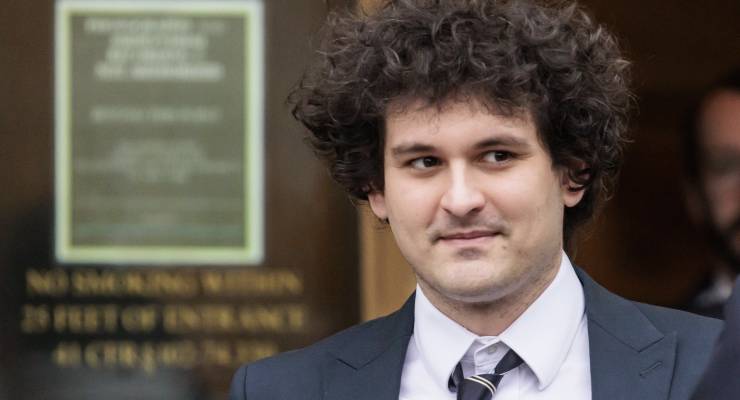
In late 2020, at the height of the pandemic, I went on a socially distanced walk with a friend. The Australian Tax Office had just announced — for the second time that year — that people could withdraw more money from their superannuation funds to alleviate COVID-19 hardship. My friend is a building site supervisor, and he was telling me about a subcontractor he employed.
“This guy,” my friend told me, “he got out as much as he could. Every last bit. And he invested it …” (a feeling of dread started to creep into my stomach. Oh god. Don’t tell me) “… in crypto.”
“Nooooooooooo!”
“He was like: ‘This is my one chance. I don’t want to be getting up at 5.30am to be on site by 7am for the rest of my life.’ ”
I’ve found myself thinking about that nameless contractor this week as the trial of cryptocurrency shitbird Sam Bankman-Fried drew to a close. Bankman-Fried’s trial has been a snapshot of its time, serving as an intersection for several very contemporary-feeling narratives: America’s curious love affair with the boy “genius” who dropped out of Stanford; the ever-widening gulf between rich and poor, and the attendant impossibility of social mobility; and crypto, the perfect “asset” for late capitalism.
The story of crypto is, in a way, just the logical conclusion of a much older trend. For decades, financial instruments have been abstracted further and further away from the assets that provide underlying value. The end result: an asset with no underlying value, that’s only worth is whatever you can convince people it’s worth. Bankman-Fried’s trial showed he was more grifter than genius, but he certainly understood this — indeed, he basically said as much in a now-notorious interview with Bloomberg columnist Matt Levine, wherein he described “yield farming” to his increasingly incredulous interlocutor.
The entire interview is very much worth reading, but to summarise, Bankman-Fried describes an empty box that acquires value by issuing tokens that “promise that anything cool that happens because of this box is going to ultimately be usable by governance vote of holders of the … tokens”.
From there, he suggests, “sophisticated traders and/or people on crypto Twitter” would drive up the box’s value by investing in it. “And suddenly, everyone’s like, ‘This is a pretty cool box, right? This is a valuable box, as demonstrated by all the money that people have decided should be in the box.’ ” He concludes by asking: “Who are we to say that they’re wrong about that?”
It’s hard to believe anyone beyond Charles Ponzi himself could have provided a neater description of a Ponzi scheme: the box has value only for as long as people pour money into it, and the only way people will continue to pour money into it is if the initial investors can realise profits by selling their tokens to the next bunch of rubes down the ladder. As soon as anyone stops and points out that the box is empty, the whole thing falls apart.
If you’ve been following the trial, you might have noticed that the box is a pretty good metaphor for FTX itself. The catalyst for the exchange’s collapse was an article pointing out that its assets largely consisted of FTT, a token issued by… FTX. The way in which a whole lot of real money invested via FTX was siphoned away to fund Bankman-Fried et al’s lifestyle and terrible investments didn’t become clear until the whole thing had fallen in a heap.
Still, it was that fact that ultimately did for Bankman-Fried, not the absurd lack of care he took with his customers’ money, or the fact that he could start a ridiculous exchange for ridiculous “assets” in the first place — and be hailed as some sort of messiah for doing so.
As with the trial of Theranos founder Elizabeth Holmes, the FTX trial demonstrates that if you want to continue running your scam without the intervention of inconvenient visits from the police and possible 100-year jail terms, the one thing you absolutely must not do is separate rich old men from their money — even though it’s apparently remarkably straightforward to do so.
And look, it’s easy to see fraud — especially fraud with fake money, fraud that largely affected people with plenty of real money to spare — as a victimless crime. But reading Bankman-Fried’s testimony — the evasiveness, the smugness, the sense of assumed, unearned superiority — I thought again about my friend’s subcontractor and his lost super.
Despite his grand delusions of being an effective altruist, I doubt Bankman-Fried even knows people like that subcontractor exist. Like many in the world of finance, he’s one of what F. Scott Fitzgerald called “careless people … [who] smashed up things and creatures and then retreated back into their money or their vast carelessness or whatever it was that kept them together, and let other people clean up the mess they had made”.
Bankman-Fried made the wrong mess, smashed up the wrong things, but all of capitalism relies to varying degrees on the exploitation of hope: hope that this time you might be the one to win a game you barely understand, that there’s a way out, that one day it might be you who gets to live in a Bahamas polycule instead of getting up at 5.30am to be on site by 7am. But it never is. This is a game that people like you and I never win.
Do you feel sorry for his victims? Let us know by writing to letters@crikey.com.au. Please include your full name to be considered for publication. We reserve the right to edit for length and clarity.








The most notable element in this miserable story is that, once again, all sorts of people who ought to know better have been exposed as gullible fools who are easily dazzled by anybody who appears to have suddenly acquired vast wealth with no very clear explanation. Financial journalists are, on the whole, among the very worst for enthusiastically grovelling at the feet of any such mountebank or charlatan who spins them a yarn. Sam Bankcon-Fraud is just the latest in a long line to be exposed. How about Enron, the ‘smartest guys in the room’, a company which at its heart was just a simple accountancy scam allowed to metastasise and grow to monstrous size? How many adoring articles were published about Bernie Madoff before it went sour, though he had nothing but a plain vanilla Ponzi scheme? And so many more. The lack of any conventional busines or accounting explanation for their profits is always seen not as suspicious, not as something that needs to be investigated, but as the clearest proof of their sublime genius, their supernatural talent, and all the more reason to adore and worship.
Better to remember what one of Balzac’s characters said in a novel published in 1834, roughly translated: behind every great fortune is a great crime.
SSR nails it.
The world is a ponzi
Sent to drain
Secret destroyers
Hold you up to the flames
And what do I get
For my pain?
Betrayed desires
And a piece of the game
Sent to dray-yay-yain
🙂
A game as old as the emperor’s New clothes
Great article. I’ve been following crypto currency and NFT’s a bit too much, and definitely have no personal stake, but I feel very sorry for the type of victims you mention, although have to admit to being often preoccupied with schadenfreude over the affluent greedy victims.
I knew someone once who turned out to be ripping off musicians and artists to little consequence, it wasn’t until someone rich got scammed that the chickens came home to roost.
Please check facts. SBF did not drop out of Stanford. He graduated from MIT with a degree in physics. It was Elisabeth Holmes of Theranos infamy who dropped out of Stanford. I doubt that SBF will serve life in prison. Dear Elisabeth only got 11 years. Then again, she defrauded rich old men of only a few hundred million not billions like SBF. Maybe he’ll get 20 years. No way will he get a life sentence.